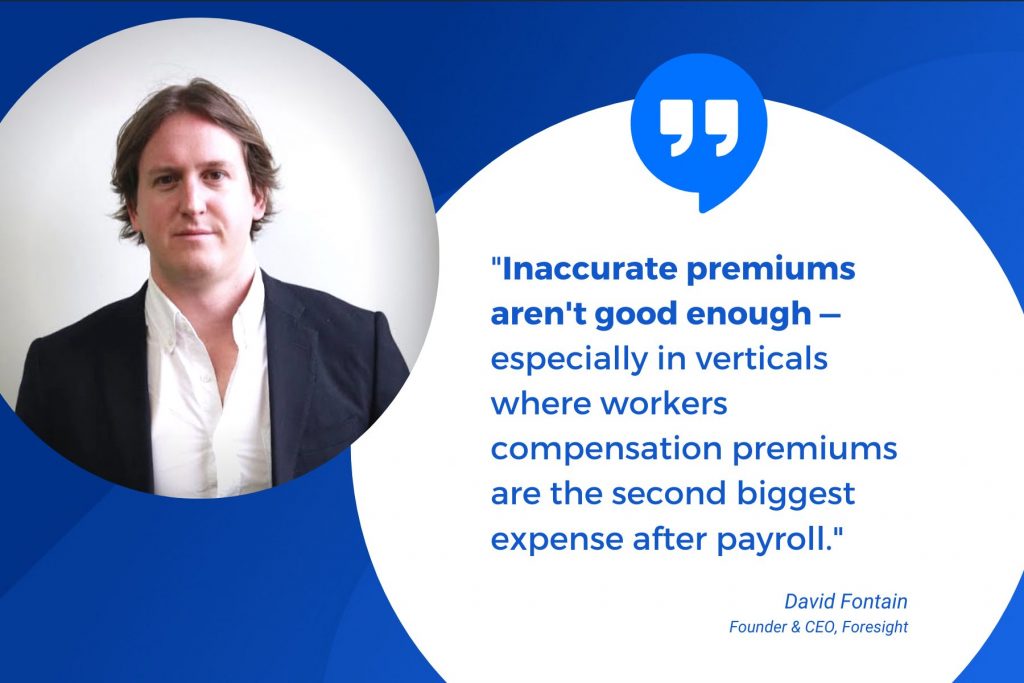Four workers comp problems that won’t exist in 10 years
By David Fontain, Founder and CEO at Foresight
Workers compensation legislation and products have a noble mission: they aim to protect employers and employees from huge losses. But whether you’re a carrier or an insured, you know both the law and the policies come with shortcomings that don’t just impact service but people’s lives.
After 100 years in existence, it’s time to reevaluate what’s working and what isn’t with workers comp. Actually, it’s past time. Back in 2016, David Michaels, the then-assistant Secretary of Labor at OSHA said the same thing in response to a report that uncovered adverse effects on workers.
Here’s the thing: workers compensation can and does work. But within ten years, a number of back-breaking problems will be completely resolved.
Problem 1: difficulty doing business
There’s one thing about workers compensation lines that carriers, service providers, brokers, and insureds can all agree upon: it’s not easy doing business in our field.
Workers compensation as it currently functions is slow, fragmented, and impersonal. But these aren’t our big problems: they’re symptoms of a bigger issue, namely failing to keep up with the prevailing technological winds of change. The lumbering operations of workers comp is a symptom of an outdated way of doing business that makes operations increasingly difficult as time goes by. It’s hard to watch, particularly as insurtechs like Lemonade shake up other areas of the insurance market.
Now we’re seeing insurtechs present digital platforms that keep data in one place, improve communication, and create better care coordination. Fragmentation is on its way out the door.
On the underwriting side, machine learning and artificial intelligence make it possible to make better decisions in less time. We’re seeing AI in quoting and underwriting today, but it won’t be long before start-ups like Welcome AI expedite the vast majority of claim payments, allowing the pros to focus on the 28% of claims that cost the most.
And when AI becomes part of standard operations, the compounded impact will be huge because data shows that faster claim processing leads to better outcomes.
All of these issues are critical for not just the profitability of workers compensation lines but for the economy. Making it easier to do business makes it easier to serve the SMB market, a market that is underserved and often overcharged today. And that leads me to the second problem that will vanish within ten years: inaccurate premiums.
Problem 2: perpetually imprecise premiums
Over the last 15 years, businesses of all sizes learned the importance of managing cash flow for survival. Cash flow was a life-or-death matter after the crash and credit crunch in 2008 and 2009, and it became a core problem this year as businesses struggled with the uncertainty of the COVID-19 economy while finding themselves battling for relief funds and grants with corporations hundreds of times their size.
The average business can’t manage its cash flow without accounting for its workers compensation premium. And too often, those premiums are imprecise or even inaccurate — and they’re always due upfront.

That’s not good enough, especially in verticals where workers compensation premiums are the second biggest expense after payroll.
The good news: outdated payroll and lump-sum premiums are on their way out the door and pay-as-you-go is here with the help of insurtech. A combination of technology like payroll integrations with new ways of thinking allow providers to assess payroll more regularly and bill more frequently. As a result, insureds face fewer surprises when audits come around, and they are better able to manage their cash flow by paying smaller, more accurate premium bills.
Overall, the system is more efficient. Inaccurate premiums are outdated, and they can’t disappear quickly enough.
Problem 3: runaway loss control
Loss control is critical to insurer solvency. Insurers have long reduced losses by reducing risk, which meant denying coverage to hairy clients or raising premium rates to punitive levels. Along came loss control programs staffed by representatives, and these programs worked: in 2017, researchers found that contact between loss teams and clients reduced lost-time injury risk after just one meeting.
Insurtechs will come to market with a greater risk management focus and a technology solution to achieve its goals. Not only are insurtechs more nimble in determining their risk appetites, they offer both software and valuable analytics derived from the insureds’ own safety data to promote systems of loss control and thereby cover more businesses at lower rates.
Problem 4: over-reliance on lagging indicators
In the field of environmental health and safety, professionals have argued for the merits of leading indicators for decades. Like preventive healthcare, leading indicators allow you to action data before an incident occurs. Unfortunately, many health and safety departments still rely on lagging indicators like the lost-time recordable incident rate.
Leading indicators are the way forward — literally. This is well known among occupational safety and health crowds, but the insurance world is only now translating it into serious plans.
Tech that turns leading indicators into actionable insights will cement the transition.
Insurtechs will renew the promise of workers compensation
Workers compensation isn’t an outdated product, but the levers behind it are in dire need of a refresh.
The good news: insurtechs are renewing the promise of workers compensation. And they’re not offering simple, band-aid fixes. Companies like Foresight are going to the heart of the system to heal old wounds and improve the process for everyone from the carrier to the worker.
Thanks to new tech and fresh mindsets, the transformation is coming, and Foresight is proud to be part of the movement that’s changing the way workers compensation works.
